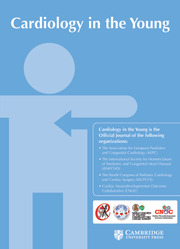No CrossRef data available.
Article contents
Use of Bivalirudin for a Pediatric Patient with Two Mechanical Heart Valves: a case report
Published online by Cambridge University Press: 17 March 2025
Abstract
Despite advances in the development of systemic anticoagulants, there remain few agents approved for utilisation in patients with mechanical heart valves. Currently, recommendations for periprocedural and long-term anticoagulation in mechanical heart valves include unfractionated heparin or vitamin K antagonists, and there are some reports for off-label use of low-molecular-weight heparins. Emerging data on parenteral direct thrombin inhibitors, such as bivalirudin, have led to increased utilisation in both extracorporeal membrane oxygenation and ventricular assist devices. We present the case of a paediatric patient with rheumatic heart disease who had significant bleeding on unfractionated heparin who successfully received prolonged bivalirudin therapy in the setting of mechanical aortic and mitral heart valves.
- Type
- Brief Report
- Information
- Copyright
- © The Author(s), 2025. Published by Cambridge University Press



